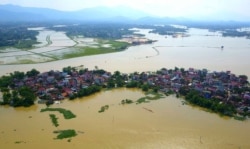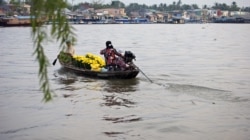It's not quite the first thing on everyone's minds in the booming financial center of Vietnam, but everyone kind of knows it might happen: Global sea levels pushed up by climate change threatens to flood the city by the year 2100.
That threat resurfaced last week when U.S.-based nonprofit news organization Climate Central published a report in Nature magazine detailing timelines and locations for ever-rising seas. From 10% to one-third of Vietnam's population would be impacted, the Oct. 29 study says.
Ho Chi Minh City, population 9 million, shows little outward concern for now. Cranes speckle the skyline to build new housing for the people who are steadily moving in from other parts of Vietnam for work or study. Ho Chi Minh City serves as an administrative center for the growing number of foreign-invested companies that manufacture goods in Vietnam for export, a source of 6%-7% annual economic expansion.
But flooding regularly hits the populous, flat coastal regions just south of the city, making people keenly aware of what would increasingly happen if the adjacent South China Sea breaches its high tide line by 2100 as suggested by the report's author, Climate Central.
"We do have to deal with climate change," said Do Van Chanh, 20, a third-year student at a Ho Chi Minh City University.
"Vietnam can be affected by global warming. Some places will be flooded. Because we have a long coast line, that's why it's going to be a problem," Chanh said. "We need to find some alternative energy, solar energy or wind or waves. It's available but it may be costly and maybe it takes a lot of efforts."
Sea levels
Global sea levels could rise half a meter this century even with "sharp, immediate cuts to carbon emissions" after going up 11 to 16 centimeters (4 to 6 inches) in the past century, two authors with Climate Central wrote. Without those cuts, it suggests, sea levels may rise more than two meters causing further instability in the Antarctic ice sheets which melt causing the sea levels to rise.
The danger zones threaten mostly people living in developing countries in Asia, the study says, including 10% of Vietnam.
"Continued high emissions with Antarctic instability could entail land currently home to roughly one-third of Bangladesh's and Vietnam's populations permanently falling below the high tide line," it says. "It follows that some coastal municipalities within these nations will see even larger proportions of their populations threatened with displacement."
Frequency of flooding
Flooding after a long downpour has become a "way of life" in the south, said Mike Lynch, managing director with SSI Institutional Brokerage in Ho Chi Minh City.
Floods occur every year in the Mekong Delta south of Ho Chi Minh City. And, British firm JBA Risk Management says that means annual economic losses are at about $71 million in the delta regions, where people raise fish or shrimp for a living.
"The thing I'd worry about in those places are that's where they have the shrimp farms, that's where their whole livelihood's based on farming," SSI's Lynch said. "There's already issues where the salt water goes up the river and as it goes up it kills the ability to grow some fish."
In 2011, severe flooding killed 265 people, damaged 449,000 houses and caused losses of $600 million.
Taking action
Wind and solar energy, antidotes to global warming, are slowly being installed around the country. Local governments are trying to clean out storm drains, while builders flood-proof new properties.
"People will advertise oh look, we've dug the foundation on this building a certain amount so we've got the drainage set up in a specific way," said Maxfield Brown, a senior associate with the business consultancy Dezan Shira & Associates. "There are major efforts being taken in numerous parts of the city to build more effective drainage, just because of the rains."









